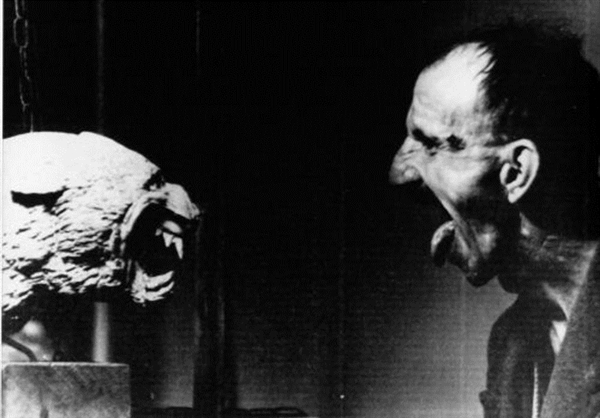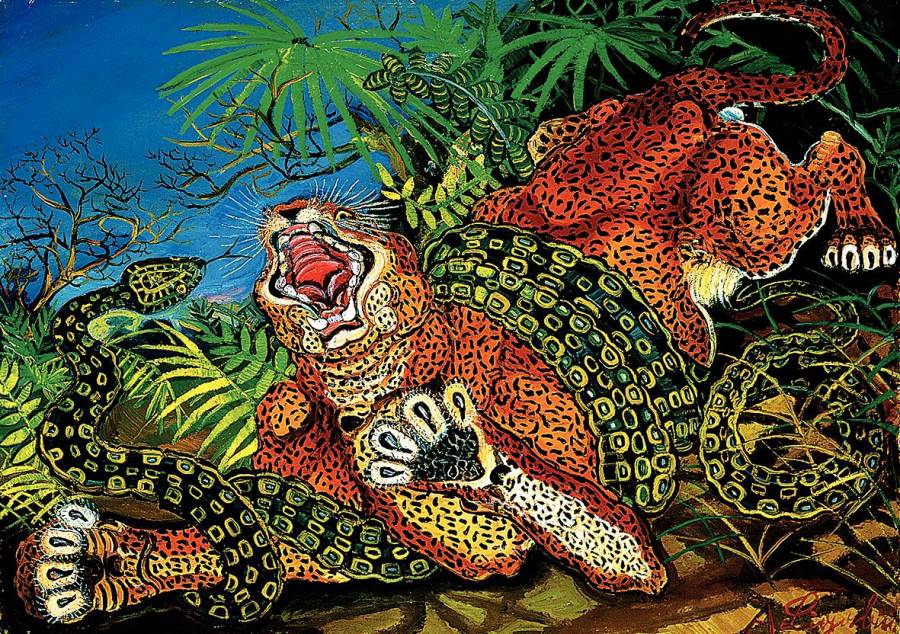Antonio Ligabue

He is one of the best-loved italian painters of the 20th century: we are talking about Antonio Ligabue (Zurich, 1899 – Gualtieri, 1965), considered the naïf painter par excellence (although this is a somewhat ‘narrow’ definition). His works continue to fascinate tens of thousands of people, his extraordinary life has been recounted in television dramas (the one with Flavio Bucci in the role of the artist is very famous), as well as in films, even recently (for example, the feature film with Elio Germano playing the painter), and his very existence is almost seen as the symbol of a revenge that came about thanks to art, given that, for most of his life, Ligabue did not really have a good life, far from it. His life was in fact very difficult.
Today, Ligabue is such a popular painter with the public that he is the protagonist of numerous exhibitions throughout Italy and abroad. In fact, Ligabue was a very original painter, with no academic training, capable of totally identifying himself with the product of his hands whether it was paintings or sculptures, as well as of moving the observer and capturing him by drawing him into his visionary world, made up of ferocious animals, memories of Switzerland, his homeland, views of the Emilian countryside and much more. Through his art, however, Ligabue was able to sublimate his vicissitudes by affirming his personality, despite the fact that at first ‘el Matt’ (this was the nickname given to him by the inhabitants of Gualtieri, his adopted village) was not understood by his contemporaries, who on the contrary mistook him for a madman and often even rejected his paintings. It was only at the end of his career that the work of the critic Renato Marino Mazzacurati opened the doors of success for him. For the artist, it was an ephemeral success, as he died a few years after having fully enjoyed the fruits of his art, but for the history of art, it is a success that can now be defined as imperishable, despite the fact that critics continue to be divided over Ligabue.
Ligabue’s greatness lies above all in his dimension as an authentic primitive, as an artist who paints without formalism but only because he is driven by an inner need that does not respond to any preconceptions or any heritage derived from study or tradition: for Ligabue, art is an innate need.
And his works are there to testify to this.

Puntesecche
Original engravings by the celebrated artist Antonio Ligabue, signed and numbered in pencil, archived and some published in the catalogue of Ligabue’s ‘Bestiary’ sculptures. These engravings are very rare not only because they are printed in very small numbers, but also because half of them were destroyed due to the vicissitudes of the author.
With certified provenance and authenticity, these engravings are gems for true connoisseurs.
Biography
Antonio Laccabue (known by everyone as Ligabue) was born on 18 December 1899 in Zurich, Switzerland, the son of Elisabetta Costa, a woman originally from Belluno, and Bonfiglio Laccabue, a man of Emilian origin (but the identity of his father has never been established with certainty). Fostered in September 1900 by a Swiss couple, Elise Hanselmann and Johannes Valentin Goebel, he was orphaned by his mother Elisabetta in 1913, when food poisoning also killed three of his siblings (Antonio, however, would consider his father responsible for Elisabetta’s death, to the point of changing his surname to Ligabue precisely because of his hatred for his parent).
The Goebel family lives in a difficult economic situation, which has a negative effect on young Antonio: suffering from vitamin deficiencies and rickets since childhood, he has to cope with a blocked physical development, which takes the form of the ungainly appearance that will accompany him even as an adult. On the other hand, the boy also shows some difficulties from an emotional and intellectual point of view: he does not like to be with his peers, preferring the closeness of animals, and he is in great difficulty at school.
Placed in a differential class in primary school, he was entrusted in 1912 to an institution for deficient boys, before being moved, the following year, to Marbach, to an institution run by an evangelical priest who would describe his conduct as ‘immoral’ because of his habit of swearing and cursing. In Marbach, in any case, Antonio learns to read with some speed, and although he is poor in mathematics and spelling, he finds constant relief in drawing, which not infrequently allows him to calm down after the nervous breakdowns that affect him.
Placed in a differential class in primary school, he was entrusted in 1912 to an institution for deficient boys, before being moved, the following year, to Marbach, to an institution run by an evangelical priest who would describe his conduct as ‘immoral’ because of his habit of swearing and cursing. In Marbach, in any case, Antonio learns to read with some speed, and although he is poor in mathematics and spelling, he finds constant relief in drawing, which not infrequently allows him to calm down after the nervous breakdowns that affect him.
Also expelled from this institute for discourteousness and bad behaviour, after having started working as a farm labourer on an occasional basis, he led a rather erratic life, and was admitted to a psychiatric clinic after a violent quarrel with Elise, his foster mother, who denounced him in 1919. Expelled from Switzerland, Antonio was taken from Chiasso to Gualtieri, his adoptive father’s town of origin (in 1955 he would dedicate a painting to the episode, entitled “Ligabue arrestato”, portraying himself in handcuffs, next to two carabinieri on a carriage), but he tried to escape immediately, also because he did not know Italian.
His escape attempt to Switzerland, however, failed, and the young man was taken back to his village and admitted to the Carri begging hospice. In 1920, he was offered work on the banks of the Po: employed as a scarifier, he helped build a road connecting Gualtieri with the river. In the same period, he devoted himself to painting for the first time.
The meeting that changed his life occurred in 1928, when Renato Marino Mazzacurati, one of the founders of the Roman School, sensed the talent hidden in his genuine art and taught him how to use oil colours. In 1932, Ligabue was welcomed by Licinio Ferretti, an internationally renowned flutist and collector of contemporary art paintings. By now directed towards a mature and complete development of his talent, Antonio decided to dedicate himself body and soul to painting, continuing his aimless travels along the Po River.
He devotes himself to paintings and drawings, which represent separate worlds: although the subjects are the same, the drawings are never preparatory studies or sketches for canvases, but autonomous exercises characterised by nervous strokes (drypoint is congenial to him), sometimes traced, often characterised by signs that are not clean but decidedly expressive and structural, with not infrequently plastic results. On the other hand, his figurative works come across as bright, even violent and nostalgic, peppered with precise details and often set in scenarios of rural life, with imagination and memory mingling according to the landscape depicted. And so Ligabue, who by now managed to support himself through painting, also devoted himself to sculpture with terracotta.
Admitted to an asylum in 1937 in Reggio Emilia for acts of self-harm, he managed to get out only four years later thanks to the intervention of the sculptor Andrea Mozzali, who welcomed him to his home in Guastalla, near Reggio Emilia. The arrival of war allowed him to be employed as an interpreter for the German troops, but in 1945 Ligabue was once again interned in an asylum, guilty of beating a German soldier with a bottle: he would remain locked up for another three years. During his confinement, Antonio continued his activity as a painter, and even received a visit from Romolo Valli, a journalist and future actor.
Once released, he resumed his painting activity with greater intensity, thanks to the increasing attention that critics, journalists and art dealers devoted to his works. Having abandoned sculpture around 1954, he devotes all his time to producing paintings, often of imposing dimensions, in which he expresses his conception of existence as a perpetual struggle, a battle without respite, only rarely interspersed with small moments of serenity. It is the self-portraits, in particular, that reveal this idea of life.
Concentrating on etching, in 1955 Ligabue held his first solo exhibition on the occasion of the ‘Fiera Millenaria’ held in Gonzaga, not far from Mantua, while the following year he took part in the ‘Premio Suzzara’. In 1957 he was the protagonist of a report (still famous today) published in the ‘Resto del Carlino’, signed by Severo Boschi and photoreporter Aldo Ferrari, who immortalised him in Gualtieri. Four years later, Ligabue had the opportunity to hold a personal exhibition in Rome, at the ‘La Barcaccia’ Gallery. Shortly afterwards, however, a motorbike accident (the last years of his life allowed him to get out of financial straits and devote himself to his passions, including motorbikes) slowed down his activity, which was further penalised by a paresis that shortly afterwards seized him: a hemiparesis due to cerebral vasculopathy that affected both his mind and body.
After being baptised and confirmed, Antonio Ligabue known as “Al tedesch” (“The German”) or “Al Matt” (“The Madman”) died on 27 May 1965, and was buried in the Gualtieri cemetery. Shortly afterwards, the IX Quadriennale in Rome dedicated a retrospective exhibition to him.
